A novel, knowledge-based concept for performance diagnosis and training adjustment in horses
Published: March 20, 2007
By: MATTHIAS BOJER - Institut für Natursport und Ökologie, Germany (Courtesy of Alltech Inc.)
When comparing the scientific approaches and efforts that are currently applied to improve performance capability in all fields of human athletic competition, it is more than obvious that scientific approaches to improve performance, training conditions or analyse training status of horses are dramatically ignored, even by top athletes in the equestrian sport. We are missing knowledge-based concepts to monitor equine fitness and strategies to improve performance capabilities based on a defined and testable training program. According to statements of top athletes, not even the performance of our top international competitors is analysed by scientific methods during an important sport event. This is partly due to the fact that most scientific research on horses focuses on medical aspects. Nevertheless, it is hard to understand why in this day and age the equestrian sport relies on traditional methods, with coach and rider relying alone on ‘gut feelings’ and experience.
A couple of years ago, the Equestrian Research and Study research group at the German Sports University of Cologne decided to transfer the methods known from traditional human sport disciplines to equestrian sports. The focus was first on the human part, the rider. But of course success in equestrian sport events does not exclusively depend on the capability of the rider. It is the performance of the ‘companion’ horse that is in most cases essential for success. In this respect, the focus of our research has changed. We have started to develop new disciplinespecific methods of performance diagnosis and training programs for the equestrian sport, with the horse as the centre of interest. This novel concept and the analytical methods are the main focus of this paper. The general idea is to create concepts for all disciplines in equestrian sports, since factors such as endurance, speed, power and coordination of movements are doubtless of general interest. In the beginning it was hard to find the acceptance and thus enough horses to generate statistically sound data.
Meanwhile we had the chance to start our scientific research in cooperation with one of the top athletes of the German International Jumping Rider team, so the data presented have been in most cases obtained with horses that perform in jumping events.
Exercise program to improve endurance
Our first approach was to create a training program to improve endurance in horses, as endurance is the basis for all disciplines. We took advantage of experience from human sports. In human sports a so-called step program is the method of choice, where the athlete is challenged in step 1 by a time-limited exercise (usually a run) under controlled conditions (i.e. a given speed) and has a defined resting period (walking). The athlete would then go through more cycles (steps 2 – x) under conditions of increasing intensity (i.e. higher speed), while the resting time is kept constant. Usually this two-step program is repeated four times. The performance of the athlete is monitored by measuring heart rate and lactic acid production as described below, and the program is designed in a way that matches individual abilities.
The design of this program, especially the challenge step, is usually the very sensitive part. If the athlete is not sufficiently challenged, the program is useless, however overtaxing is devastating, but will be revealed by physiological measurements such that the program can be adapted.
Our step program for horses is as follows: Before the test begins, the resting heart rate and the resting lactic acid concentration are determined. Horses are allowed to warm up before the first step is started. Step 1 includes a gallop with a speed of 325 meters/ min for 5 min. A short rest (1-2 min) follows and the first aliquot of capillary blood is taken. During Step 2, the speed is increased by 50 meters/min (i.e. to 375 meters/minute), but the challenge time is kept at 5 min. Two more steps are performed, each time increasing the speed by 50 meters/min and keeping the challenge time constant. It should be emphasized at this point, that the speed of the first step and the number of steps strongly depends on the endurance capability of the respective horse, and must be adjusted individually.
ESTABLISHING PHYSIOLOGICAL MEASUREMENTS THAT DESCRIBE ENDURANCE
Performance during an athletic competition certainly depends on a discipline-specific endurance. The endurance factor is important in dressage and jumping and gains further importance in cross-country or long distance racing events. Despite the differing demands of these events, general performance parameters can be established to monitor endurance in each discipline.
With a glance at what has been learned from human athletes performing in gymnastics, heart rate and lactic acid accumulation in the blood should be the parameters of choice. It can be considered as a general rule in sports physiology that during exercise the heart rate increases. If the athlete is well-trained, this heart rate drops when he returns to moderate movement or rest. The rate of decrease in heart rate has been shown to reflect a good training condition in humans.
Thus our first approach was to establish a means of continuously recording heart rate of horses during exercise. As in humans, electrodes were fixed on the body of the horse and linked to a recorder enabling us to monitor this physiological parameter during exercise. Figure 1 shows the simple experimental setup and a recording that was done during a regular horseback riding lesson. Heart rate reached top values of 120-130 beats/min during the lesson and when walking the heart rate came to steady-state levels within 5 min. When challenging horses in the step program, heart rate values of up to 180 beats/minutes and more were observed (Figure 2).
Maximal heart rates are certainly individual characteristics. Even in horses we observed heart rates up to 200 beats/min and more during Grand Prix Jumping events, so they cannot be considered the only marker of fitness.
Lactic acid accumulation is another marker that is generally applied to assay exercise and endurance in humans (Hollmann and Hettinger 1990). The biochemical explanation is that during exercise, needed energy is provided by two metabolic principles, which will be considered in brief.
The general energy source, glucose, is metabolised to pyruvate by a pathway called glycolysis. This 11- step pathway creates two molecules of ATP, the energy currency of the body (which can be spent for energy-consuming work such as muscle contraction), and one reduction equivalent. It is important to note that these reactions will occur without the presence of oxygen, thus they are called the anaerobic reactions of glucose metabolism. Pyruvate is then metabolised by the citric acid cycle to carbon dioxide, generating reduction equivalents that can be used in the respiration chain, which uses these reduction equivalents to reduce oxygen to water, thus generating much more energy in the form of ATP than glycolysis.
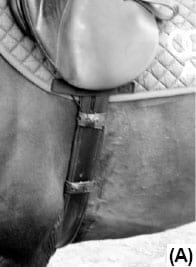
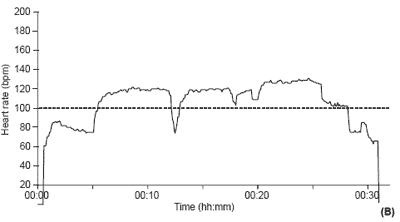
Figure 1. (A) Electrodes were fixed with tapes to the body of a horse and connected to the recorder at the rider’s wrist. (B) Recorded time course of the heart rate of a horse during a regular riding lesson.
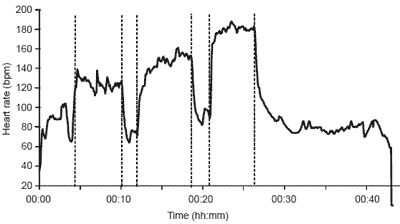
Figure 2. Time course of the heart rate of a horse challenged by our step test.
This is the aerobic part of glucose metabolism. During exhaustive exercise when the rate of oxygen consumption due to the work of the respiratory chain gets high, oxygen cannot be delivered by haemoglobin in the appropriate amount, so the ATP-energy-producing respiratory chain is not able to provide enough ATP for the muscle cell. Thus, the cell relies on its oxygen-independent pathway, glycolysis (Figure 3). Glycolysis can only proceed if the reduction equivalent produced in its reaction steps is converted to oxidation equivalent; and only if the accumulating pyruvate, which cannot enter the citric acid cycle, is removed. Thus the cell reacts by converting pyruvate to lactic acid with the help of the reduction equivalent. The amount of lactic acid transferred to the blood can be considered as a marker of exhaustive work.
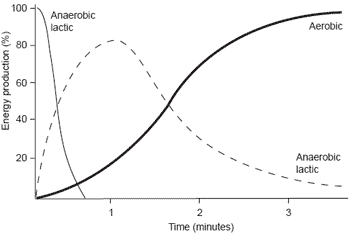
Figure 3. The time process of aerobic and aneraerobic reactions (Clayton, 1991).
A study by Hodgson and Rose (1994) revealed that horses, independent of athletic discipline, usually perform under aerobic conditions. In humans it is known that well-trained athletes accumulate lower concentrations of lactic acid in the blood than nontrained individuals (Hollman and Hettinger, 1990).
Lactic acid is usually assayed in a small aliquot of capillary blood in anticoagulant solution, which is kept on ice until laboratory analysis (Figure 4).
During the step test blood samples were taken to monitor lactic acid accumulation (Figure 5). All horses accumulated lactic acid to some extent, depending on fitness level. From human studies it is known that the blood serum lactic acid concentration influences performance capabilities (Heck and Rosskopf, 1994).
Humans get ‘sour’ when they reach a well known threshold of lactic acid accumulation and can no longer perform with coordinated movements. In humans the threshold is 4 mM lactic acid; and we observed the same threshold for horses as well. These results point to the fact that during exhaustive exercise horses react with lactic acid formation, the extent of which depends on the individual performance capacity of the horse; and this parameter must be considered during controlled exercise in order not to overtax the horse.
On the other hand, in the timed schedules applied, heart rate and lactic acid accumulation will reflect the endurance capability and the progress of the individual horse.
While the assay methods described above can be generally applied, the step test can certainly be modified. Recently we have started to develop step tests for jumping horses, which include a standardized course. In addition, we monitored some of our jumping horses during international events by measuring heart rate and lactic acid formation to better estimate the stress during these big events.
Outlook
THE SPEED, POWER AND COORDINATION FACTORS
In many equestrian sports speed, power and coordination are additional factors that determine success. Certainly these factors are interrelated. We have recently started to precisely monitor the speed and acceleration capacity of jumping horses with a LAVEG-speed analyser, which is based on laser technology. The question is whether a special program to improve acceleration that is known from other athletic programs (i.e. short sprints followed by a resting period) is effective in horses as well. In preparation are programs to improve and actually monitor power with the help of weight-adjustable sledges. But this special program must be disciplinespecific, because horses performing in dressage, jumping or cross-country all have individual demands. One consideration is: does the horse need maximal power throughout the performance, or do we need to improve ‘maximal power on the point’? In other words, does a horse that performs in dressage for 5 min need maximal power during all this time, or just when performing power-consuming manoeuvers like passage?
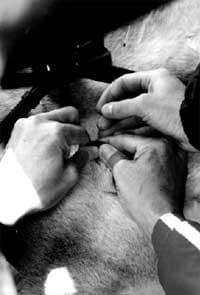
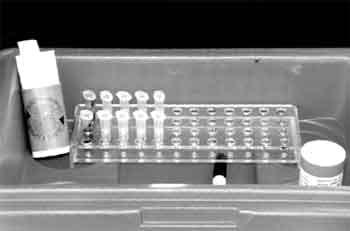
Figure 4. (A) An aliquot of capillary blood is taken from the horse and transferred to (B) Eppendorf tubes filled with anticoagulant solution and kept on ice.

Figure 5. Time course of lactic acid formation in horses challenged with the same step test as in Figure 2 (Bojer and Schulz, 2000).
The most complex factor is coordination. To analyze the various kinetic aspects during jumping (i.e. jumping distance to the fence, time of last contact with the soil or technique while jumping) high-speed video movies were recorded and evaluated (Figure 6). The scientific question is whether training can improve these kinetic parameters.
Taken together, we have collected a broad spectrum of analytical methods to analyse and monitor horses during sport events. Training programs known to have successfully improved performance in the human sports were adapted. All these approaches definitely must be accompanied by training diaries, regular veterinary check-ups, weight controls and specialized feeding programs.

Figure 6. 2-D kinetic analysis of horse and rider (Pozzo et al., 2001).
References
A couple of years ago, the Equestrian Research and Study research group at the German Sports University of Cologne decided to transfer the methods known from traditional human sport disciplines to equestrian sports. The focus was first on the human part, the rider. But of course success in equestrian sport events does not exclusively depend on the capability of the rider. It is the performance of the ‘companion’ horse that is in most cases essential for success. In this respect, the focus of our research has changed. We have started to develop new disciplinespecific methods of performance diagnosis and training programs for the equestrian sport, with the horse as the centre of interest. This novel concept and the analytical methods are the main focus of this paper. The general idea is to create concepts for all disciplines in equestrian sports, since factors such as endurance, speed, power and coordination of movements are doubtless of general interest. In the beginning it was hard to find the acceptance and thus enough horses to generate statistically sound data.
Meanwhile we had the chance to start our scientific research in cooperation with one of the top athletes of the German International Jumping Rider team, so the data presented have been in most cases obtained with horses that perform in jumping events.
Exercise program to improve endurance
Our first approach was to create a training program to improve endurance in horses, as endurance is the basis for all disciplines. We took advantage of experience from human sports. In human sports a so-called step program is the method of choice, where the athlete is challenged in step 1 by a time-limited exercise (usually a run) under controlled conditions (i.e. a given speed) and has a defined resting period (walking). The athlete would then go through more cycles (steps 2 – x) under conditions of increasing intensity (i.e. higher speed), while the resting time is kept constant. Usually this two-step program is repeated four times. The performance of the athlete is monitored by measuring heart rate and lactic acid production as described below, and the program is designed in a way that matches individual abilities.
The design of this program, especially the challenge step, is usually the very sensitive part. If the athlete is not sufficiently challenged, the program is useless, however overtaxing is devastating, but will be revealed by physiological measurements such that the program can be adapted.
Our step program for horses is as follows: Before the test begins, the resting heart rate and the resting lactic acid concentration are determined. Horses are allowed to warm up before the first step is started. Step 1 includes a gallop with a speed of 325 meters/ min for 5 min. A short rest (1-2 min) follows and the first aliquot of capillary blood is taken. During Step 2, the speed is increased by 50 meters/min (i.e. to 375 meters/minute), but the challenge time is kept at 5 min. Two more steps are performed, each time increasing the speed by 50 meters/min and keeping the challenge time constant. It should be emphasized at this point, that the speed of the first step and the number of steps strongly depends on the endurance capability of the respective horse, and must be adjusted individually.
ESTABLISHING PHYSIOLOGICAL MEASUREMENTS THAT DESCRIBE ENDURANCE
Performance during an athletic competition certainly depends on a discipline-specific endurance. The endurance factor is important in dressage and jumping and gains further importance in cross-country or long distance racing events. Despite the differing demands of these events, general performance parameters can be established to monitor endurance in each discipline.
With a glance at what has been learned from human athletes performing in gymnastics, heart rate and lactic acid accumulation in the blood should be the parameters of choice. It can be considered as a general rule in sports physiology that during exercise the heart rate increases. If the athlete is well-trained, this heart rate drops when he returns to moderate movement or rest. The rate of decrease in heart rate has been shown to reflect a good training condition in humans.
Thus our first approach was to establish a means of continuously recording heart rate of horses during exercise. As in humans, electrodes were fixed on the body of the horse and linked to a recorder enabling us to monitor this physiological parameter during exercise. Figure 1 shows the simple experimental setup and a recording that was done during a regular horseback riding lesson. Heart rate reached top values of 120-130 beats/min during the lesson and when walking the heart rate came to steady-state levels within 5 min. When challenging horses in the step program, heart rate values of up to 180 beats/minutes and more were observed (Figure 2).
Maximal heart rates are certainly individual characteristics. Even in horses we observed heart rates up to 200 beats/min and more during Grand Prix Jumping events, so they cannot be considered the only marker of fitness.
Lactic acid accumulation is another marker that is generally applied to assay exercise and endurance in humans (Hollmann and Hettinger 1990). The biochemical explanation is that during exercise, needed energy is provided by two metabolic principles, which will be considered in brief.
The general energy source, glucose, is metabolised to pyruvate by a pathway called glycolysis. This 11- step pathway creates two molecules of ATP, the energy currency of the body (which can be spent for energy-consuming work such as muscle contraction), and one reduction equivalent. It is important to note that these reactions will occur without the presence of oxygen, thus they are called the anaerobic reactions of glucose metabolism. Pyruvate is then metabolised by the citric acid cycle to carbon dioxide, generating reduction equivalents that can be used in the respiration chain, which uses these reduction equivalents to reduce oxygen to water, thus generating much more energy in the form of ATP than glycolysis.


Figure 1. (A) Electrodes were fixed with tapes to the body of a horse and connected to the recorder at the rider’s wrist. (B) Recorded time course of the heart rate of a horse during a regular riding lesson.

Figure 2. Time course of the heart rate of a horse challenged by our step test.
This is the aerobic part of glucose metabolism. During exhaustive exercise when the rate of oxygen consumption due to the work of the respiratory chain gets high, oxygen cannot be delivered by haemoglobin in the appropriate amount, so the ATP-energy-producing respiratory chain is not able to provide enough ATP for the muscle cell. Thus, the cell relies on its oxygen-independent pathway, glycolysis (Figure 3). Glycolysis can only proceed if the reduction equivalent produced in its reaction steps is converted to oxidation equivalent; and only if the accumulating pyruvate, which cannot enter the citric acid cycle, is removed. Thus the cell reacts by converting pyruvate to lactic acid with the help of the reduction equivalent. The amount of lactic acid transferred to the blood can be considered as a marker of exhaustive work.

Figure 3. The time process of aerobic and aneraerobic reactions (Clayton, 1991).
A study by Hodgson and Rose (1994) revealed that horses, independent of athletic discipline, usually perform under aerobic conditions. In humans it is known that well-trained athletes accumulate lower concentrations of lactic acid in the blood than nontrained individuals (Hollman and Hettinger, 1990).
Lactic acid is usually assayed in a small aliquot of capillary blood in anticoagulant solution, which is kept on ice until laboratory analysis (Figure 4).
During the step test blood samples were taken to monitor lactic acid accumulation (Figure 5). All horses accumulated lactic acid to some extent, depending on fitness level. From human studies it is known that the blood serum lactic acid concentration influences performance capabilities (Heck and Rosskopf, 1994).
Humans get ‘sour’ when they reach a well known threshold of lactic acid accumulation and can no longer perform with coordinated movements. In humans the threshold is 4 mM lactic acid; and we observed the same threshold for horses as well. These results point to the fact that during exhaustive exercise horses react with lactic acid formation, the extent of which depends on the individual performance capacity of the horse; and this parameter must be considered during controlled exercise in order not to overtax the horse.
On the other hand, in the timed schedules applied, heart rate and lactic acid accumulation will reflect the endurance capability and the progress of the individual horse.
While the assay methods described above can be generally applied, the step test can certainly be modified. Recently we have started to develop step tests for jumping horses, which include a standardized course. In addition, we monitored some of our jumping horses during international events by measuring heart rate and lactic acid formation to better estimate the stress during these big events.
Outlook
THE SPEED, POWER AND COORDINATION FACTORS
In many equestrian sports speed, power and coordination are additional factors that determine success. Certainly these factors are interrelated. We have recently started to precisely monitor the speed and acceleration capacity of jumping horses with a LAVEG-speed analyser, which is based on laser technology. The question is whether a special program to improve acceleration that is known from other athletic programs (i.e. short sprints followed by a resting period) is effective in horses as well. In preparation are programs to improve and actually monitor power with the help of weight-adjustable sledges. But this special program must be disciplinespecific, because horses performing in dressage, jumping or cross-country all have individual demands. One consideration is: does the horse need maximal power throughout the performance, or do we need to improve ‘maximal power on the point’? In other words, does a horse that performs in dressage for 5 min need maximal power during all this time, or just when performing power-consuming manoeuvers like passage?


Figure 4. (A) An aliquot of capillary blood is taken from the horse and transferred to (B) Eppendorf tubes filled with anticoagulant solution and kept on ice.

Figure 5. Time course of lactic acid formation in horses challenged with the same step test as in Figure 2 (Bojer and Schulz, 2000).
The most complex factor is coordination. To analyze the various kinetic aspects during jumping (i.e. jumping distance to the fence, time of last contact with the soil or technique while jumping) high-speed video movies were recorded and evaluated (Figure 6). The scientific question is whether training can improve these kinetic parameters.
Taken together, we have collected a broad spectrum of analytical methods to analyse and monitor horses during sport events. Training programs known to have successfully improved performance in the human sports were adapted. All these approaches definitely must be accompanied by training diaries, regular veterinary check-ups, weight controls and specialized feeding programs.

Figure 6. 2-D kinetic analysis of horse and rider (Pozzo et al., 2001).
References
Bojer, M. and T. Schulz. 2000). Hämatologische Untersuchungen von Tierblut mit dem AC-T diff in der sportmedizinischen Forschung. In: Beckmann Coulter GmbH: In vitro (5), Krefeld, pp. 52-53.
Clayton, H.M. 1991.Conditioning sport horses. Sport Horse publication. Mason, Canada.
Heck, H. and P. Rosskopf. 1994. Grundlagen verschiedener Laktatschwellenkonzepte und ihre Bedeutung für die Trainingssteuerung. In: Stellenwert der Laktatbestimmung in der Leistungsdiagnostik (D. Clasing, H. Weicker und D. Bötting, eds). Gustav Fischer Verlag, Stuttgart, Jena, New York, pp. 113-131.
Hodgson, D.R. and R.J. Rose. 1994. The athletic horse-principles and practise of equine sports medicine. WB Saunders Company. Hollmann, W. and T.H. Hettinger. 1990.
Sportmedizin – Arbeits- und Trainings-grundlagen. 3 Auflage, Schattauer Verlag, Stuttgart, New York. Pozzo, R., K. Lütteken and M. Bojer. 2001.
Kinematische Analyse der Springtechnik bei Spitzenreitern; 6.Symposium der dvs-Sektion Biomechanik Deutsche Vereinigung für Sportwissenschaft Konstanz.
Author: MATTHIAS BOJER
Institut für Natursport und Ökologie, Abteilung Reitsport, Deutsche Sporthochschule Köln, Germany
Related topics
Join to be able to comment.
Once you join Engormix, you will be able to participate in all content and forums.
* Required information
Would you like to discuss another topic? Create a new post to engage with experts in the community.
Create a post